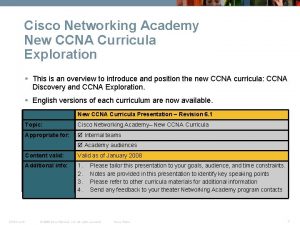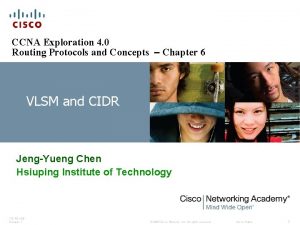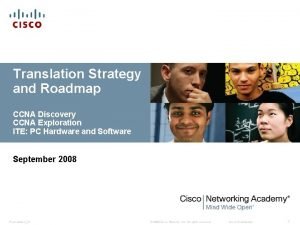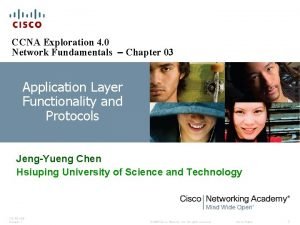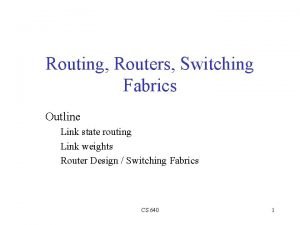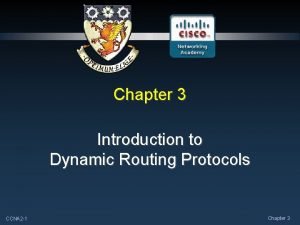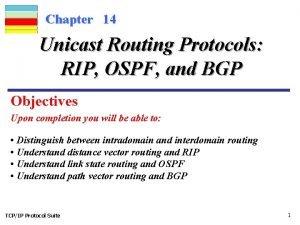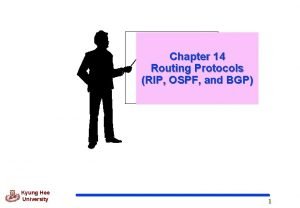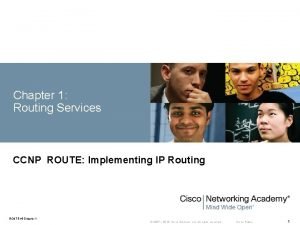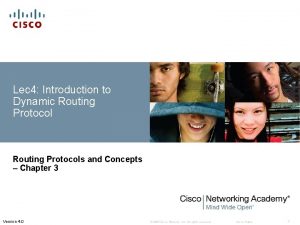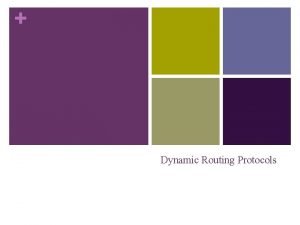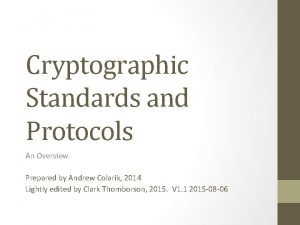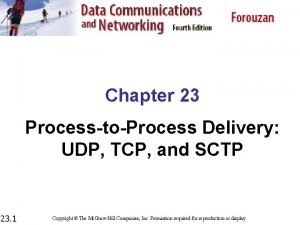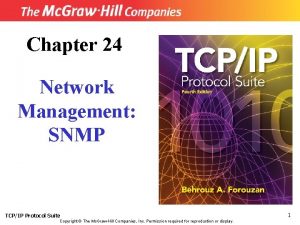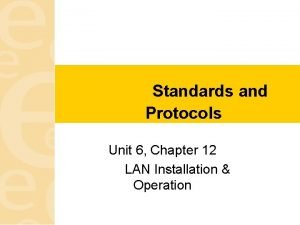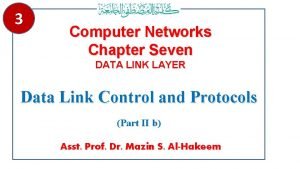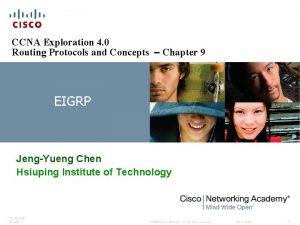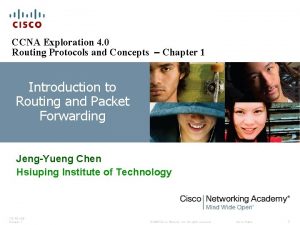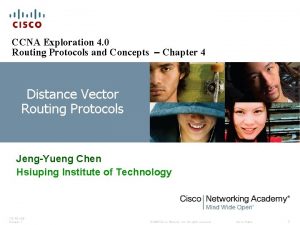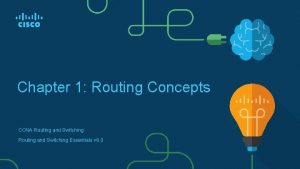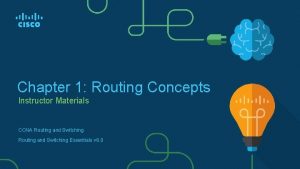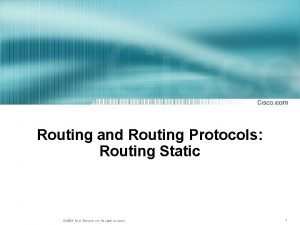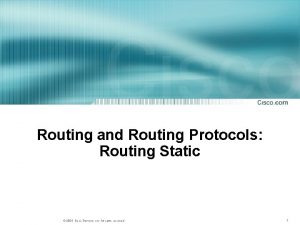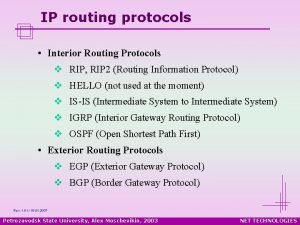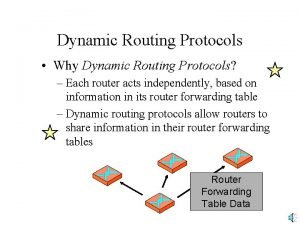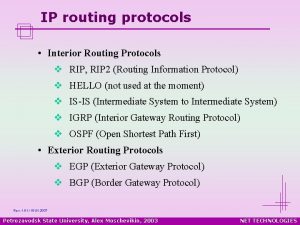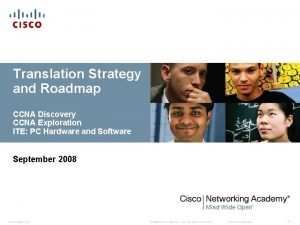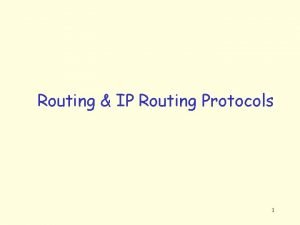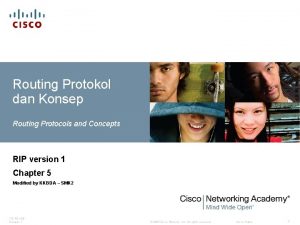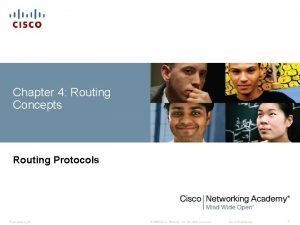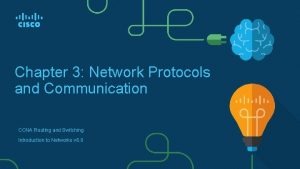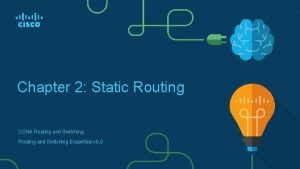CCNA Exploration 4 0 Routing Protocols and Concepts




























- Slides: 28

CCNA Exploration 4. 0 Routing Protocols and Concepts – Chapter 6 VLSM and CIDR Jeng-Yueng Chen Hsiuping Institute of Technology ITE PC v 4. 0 Chapter 1 © 2007 Cisco Systems, Inc. All rights reserved. Cisco Public 1

Objective 2 ITE PC v 4. 0 Chapter 1 © 2007 Cisco Systems, Inc. All rights reserved. Cisco Public 2

6. 1 Classful and Classless Addressing ITE PC v 4. 0 Chapter 1 © 2007 Cisco Systems, Inc. All rights reserved. Cisco Public 3

Classful IP Addressing n When the ARPANET was commissioned in 1969, no one anticipated that the Internet would explode out of the humble beginnings of this research project n By 1989, ARPANET had been transformed into what we now call the Internet. Over the next decade, the number of hosts on the Internet grew exponentially, from 159, 000 in October 1989, to over 72 million by the end of the millennium n As of January 2007, there were over 433 million hosts on the Internet. n Without the introduction of VLSM and CIDR notation in 1993 (RFC 1519), Network Address Translator (NAT) in 1994 (RFC 1631), and private addressing in 1996 (RFC 1918), the IPv 4 32 -bit address space would now be exhausted. 4 ITE PC v 4. 0 Chapter 1 © 2007 Cisco Systems, Inc. All rights reserved. Cisco Public 4

Classful IP Addressing 5 ITE PC v 4. 0 Chapter 1 © 2007 Cisco Systems, Inc. All rights reserved. Cisco Public 5

The High Order Bits n n n IPv 4 addresses were initially allocated based on class. In the original specification of IPv 4 (RFC 791) released in 1981, the authors established the classes to provide three different sizes of networks for large, medium and small organizations As a result, class A, B and C addresses were defined with a specific format for the high order bits High order bits are the left-most bits in a 32 -bit address 6 ITE PC v 4. 0 Chapter 1 © 2007 Cisco Systems, Inc. All rights reserved. Cisco Public 6

IPv 4 Classful Addressing Structure n The designations of network bits and host bits were established in RFC 790 (released with RFC 791) n Class A networks used the first octet for network assignment, which translated to a 255. 0. 0. 0 classful subnet mask. With 24 bits in the host portion, each class A address had the potential for over 16 million individual host addresses n Class B was not much better. RFC 790 specified the first two octets as network. With the first two bits already established as 1 and 0, 14 bits remained in the first two octets for assigning networks, which resulted in 16, 384 class B network addresses. Because each class B network address contained 16 bits in the host portion, it controlled 65, 534 addresses 7 ITE PC v 4. 0 Chapter 1 © 2007 Cisco Systems, Inc. All rights reserved. Cisco Public 7

IPv 4 Classful Addressing Structure n To make things worse, class C addresses were often too small! RFC 790 specified the first three octets as network. With the first three bits established as 1 and 0, 21 bits remained for assigning networks for over 2 million class C networks. But, each class C network only had 8 bits in the host portion, or 254 possible host addresses 8 ITE PC v 4. 0 Chapter 1 © 2007 Cisco Systems, Inc. All rights reserved. Cisco Public 8

IPv 4 Classful Addressing Structure 9 ITE PC v 4. 0 Chapter 1 © 2007 Cisco Systems, Inc. All rights reserved. Cisco Public 9

Classful Routing Updates n Using classful IP addresses meant that the subnet mask of a network address could be determined by the value of the first octet, or more accurately, the first three bits of the address n Routing protocols, such as RIPv 1 only needed to propagate the network address of known routes and did not need to include the subnet mask in the routing update Ø This is because the router receiving the routing update could determine the subnet mask simply by examining the value of the first octet in the network address, or by applying its ingress interface mask for subnetted routes Ø The subnet mask was directly related to the network address 10 ITE PC v 4. 0 Chapter 1 © 2007 Cisco Systems, Inc. All rights reserved. Cisco Public 10

Classful Routing Updates 11 ITE PC v 4. 0 Chapter 1 © 2007 Cisco Systems, Inc. All rights reserved. Cisco Public 11

Classful Routing Updates 12 ITE PC v 4. 0 Chapter 1 © 2007 Cisco Systems, Inc. All rights reserved. Cisco Public 12

Classless Inter-Domain Routing n In 1993, IETF introduced Classless Inter-Domain Routing, or CIDR (RFC 1517). CIDR allowed for: Ø More efficient use of IPv 4 address space Ø Prefix n aggregation, which reduced the size of routing tables To CIDR-compliant routers, address class is meaningless Ø The network portion of the address is determined by the network subnet mask, also known as the network prefix, or prefix length (/8, /19, etc. ). The network address is no longer determined by the class of the address. n ISPs were no longer limited to a /8, /16, or /24 subnet mask. Blocks of IP addresses could be assigned to a network based on the requirements of the customer, ranging from a few hosts to hundreds or thousands of hosts. 13 ITE PC v 4. 0 Chapter 1 © 2007 Cisco Systems, Inc. All rights reserved. Cisco Public 13

CIDR and Route Summarization n CIDR uses Variable Length Subnet Masks (VLSM) to allocate IP addresses to subnets according to individual need rather than by class Ø This type of allocation allows the network/host boundary to occur at any bit in the address. Networks can be further divided or subnetted into smaller and smaller subnets n CIDR allowed for prefix aggregation (route summarization) Ø Internet routing tables were now able to benefit from the same type of aggregation of routes Ø The ability for routes to be summarized as a single route helps reduce the size of Internet routing tables 14 ITE PC v 4. 0 Chapter 1 © 2007 Cisco Systems, Inc. All rights reserved. Cisco Public 14

CIDR and Route Summarization The 192. 168. 0. 0/20 summarized or aggregated route includes all the networks belonging to Customers A, B, C, and D. This type of route is known as a supernet route. A supernet summarizes multiple network addresses with a mask less than the classful mask. Propagating VLSM and supernet routes requires a classless routing protocol, because the subnet mask can no longer be determined by the value of the first octet. 15 ITE PC v 4. 0 Chapter 1 © 2007 Cisco Systems, Inc. All rights reserved. Cisco Public 15

Classless Routing Protocols n Classless routing protocols include RIPv 2, EIGRP, OSPF, ISIS, and BGP Ø These routing protocols include the subnet mask with the network address in their routing updates Ø Classless routing protocols are necessary when the mask cannot be assumed or determined by the value of the first octet n Classful routing protocols cannot send supernet routes because the receiving router will apply the default classful to the network address in the routing update 16 ITE PC v 4. 0 Chapter 1 © 2007 Cisco Systems, Inc. All rights reserved. Cisco Public 16

Classless Routing Protocols Note: Using a classful routing protocol, R 2 can send these individual networks without summarization, but the benefits of summarization are lost ITE PC v 4. 0 Chapter 1 © 2007 Cisco Systems, Inc. All rights reserved. Cisco Public 17 17

6. 2 VLSM ITE PC v 4. 0 Chapter 1 © 2007 Cisco Systems, Inc. All rights reserved. Cisco Public 18

VLSM in Action n After a network address is subnetted, those subnets can be further subnetted ØAs you most likely recall, VLSM is simply subnetting a subnet. VLSM can be thought of as sub-subnetting. 19 ITE PC v 4. 0 Chapter 1 © 2007 Cisco Systems, Inc. All rights reserved. Cisco Public 19

VLSM in Action 20 ITE PC v 4. 0 Chapter 1 © 2007 Cisco Systems, Inc. All rights reserved. Cisco Public 20

VLSM and IP Addresses n Another way to view the VLSM subnets is to list each subnet and its sub-subnets ØWith classful routing, that is as far as you can go. You can only choose one mask for all your networks ØWith VLSM and classless routing, you have more flexibility to create additional network addresses and use a mask that fits your needs 21 ITE PC v 4. 0 Chapter 1 © 2007 Cisco Systems, Inc. All rights reserved. Cisco Public 21

VLSM and IP Addresses 22 ITE PC v 4. 0 Chapter 1 © 2007 Cisco Systems, Inc. All rights reserved. Cisco Public 22

VLSM and IP Addresses 23 ITE PC v 4. 0 Chapter 1 © 2007 Cisco Systems, Inc. All rights reserved. Cisco Public 23

6. 3 CIDR ITE PC v 4. 0 Chapter 1 © 2007 Cisco Systems, Inc. All rights reserved. Cisco Public 24

Route Summarization n Route summarization also known as route aggregation, is the process of advertising a contiguous set of addresses as a single address with a less-specific, shorter subnet mask. Remember that CIDR is a form of route summarization and is synonymous with the term supernetting n CIDR ignores the limitation of classful boundaries, and allows summarization with masks that are less than that of the default classful mask. This type of summarization helps reduce the number of entries in routing updates and lowers the number of entries in local routing tables. It also helps reduce bandwidth utilization for routing updates and results in faster routing table lookups 25 ITE PC v 4. 0 Chapter 1 © 2007 Cisco Systems, Inc. All rights reserved. Cisco Public 25

Route Summarization 26 ITE PC v 4. 0 Chapter 1 © 2007 Cisco Systems, Inc. All rights reserved. Cisco Public 26

Calculating Route Summary 27 ITE PC v 4. 0 Chapter 1 © 2007 Cisco Systems, Inc. All rights reserved. Cisco Public 27

28 ITE PC v 4. 0 Chapter 1 © 2007 Cisco Systems, Inc. All rights reserved. Cisco Public 28
 Lab 4-1: routing concepts and protocols
Lab 4-1: routing concepts and protocols Cisco ccna exploration
Cisco ccna exploration Intermediary devices
Intermediary devices Ccna exploration 4
Ccna exploration 4 Ccna roadmap
Ccna roadmap Ccna exploration 4
Ccna exploration 4 Routing and switching
Routing and switching Routing and switching protocols
Routing and switching protocols Inter vlan routing layer 3 switch
Inter vlan routing layer 3 switch Routing protocols administrative distance
Routing protocols administrative distance Write a detailed note on unicast routing protocols
Write a detailed note on unicast routing protocols Rip vs ospf vs bgp
Rip vs ospf vs bgp Routing protocols administrative distance
Routing protocols administrative distance Introduction to dynamic routing protocols
Introduction to dynamic routing protocols Routing protocols
Routing protocols Reservoir flood routing worked examples
Reservoir flood routing worked examples Mark tinka
Mark tinka Hydrologic routing and hydraulic routing
Hydrologic routing and hydraulic routing Power routing in vlsi
Power routing in vlsi Proofs of work and bread pudding protocols
Proofs of work and bread pudding protocols Layer 2 wan technologies
Layer 2 wan technologies Cryptography standards and protocols
Cryptography standards and protocols Tcp and sctp are both layer protocols
Tcp and sctp are both layer protocols Network topologies and protocols
Network topologies and protocols Snmp uses two other protocols and
Snmp uses two other protocols and Lan standards and protocols
Lan standards and protocols Data link layer protocols for noisy and noiseless channels
Data link layer protocols for noisy and noiseless channels Plc norms
Plc norms Protocols and standards in computer networks
Protocols and standards in computer networks

